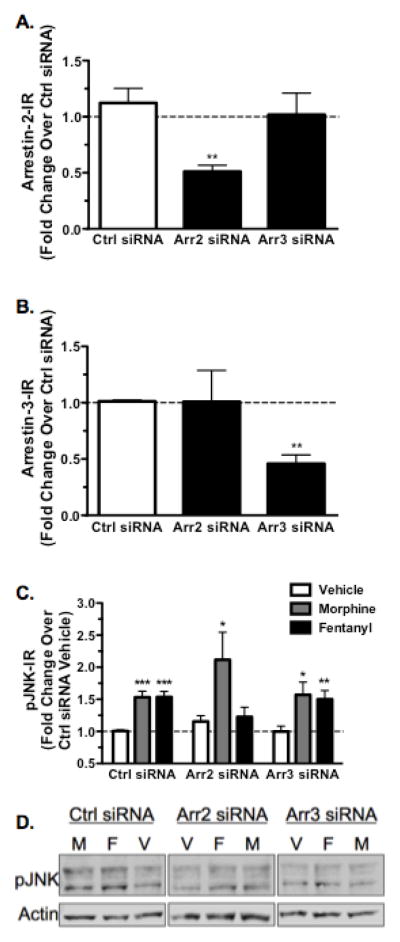FIGURE 4.
Fentanyl Mediated Phospho-JNK Increase is Abolished Following Treatment with Arrestin-2 siRNA. MOR-GFP expressing HEK293 cells were transfected with siRNA against arrestin-2, arrestin-3, or a scrambled siRNA control. Cells were subsequently lysed for arrestin-2 and -3-IR (A) or treated with vehicle (H2O), 10μM morphine, or 10μM fentanyl for 30 min before lysis and analysis of phospho-JNK-IR for each sample, which was normalized as a percent of scrambled siRNA vehicle treated cells (C,D). A, Arrestin-2 siRNA reduced arrestin-2-IR by 49 ± 5.6%. Arrestin-3 siRNA did not significantly reduce arrestin-2-IR compared to a scrambled siRNA control (ctrl). B, Similarly, arrestin-2 siRNA did not significantly alter arrestin-3-IR compared to a scrambled siRNA control, whereas arrestin-3 siRNA reduced arrestin-3-IR by 54 ± 7.8%. C, Morphine treatment increased phospho-JNK-IR regardless of siRNA treatment, indicating that arrestin is not involved in morphine activation of JNK. Fentanyl, however, increased phospho-JNK-IR in control siRNA (ctrl) and arrestin-3 siRNA treated cells but this effect was abolished in arrestin-2 siRNA treated cells, indicating that arrestin-2 is required for fentanyl activation of JNK. D, Representative westerns are shown for each JNK dataset. n=10–13; Data analyzed by one-sample t-test (ctrl only) and student’s t-test with Welch’s correction when necessary.

